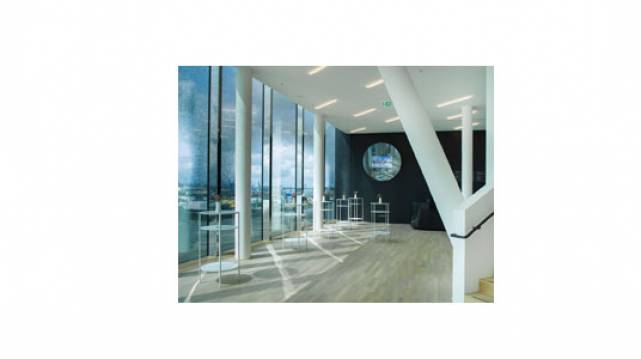Mirror, mirror: If the screen remains switched off behind the glass, the MIRONA® mineral glass coated on both sides acts like a mirror
The curved glass facade of Hamburg’s Elbphilharmonie looks like a massive wave floating 360 feet (110 meters) above the Elbe River. However, glass, a highly adaptable material, has done more than leave a lasting impression on passers-by admiring the concert hall’s exterior architecture. Inside, the semi-transparent MIRONA® glass from SCHOTT brings out surprising reactions: at first, it appears to be a mirror before it magically transforms into an information display.
Awe is the best way to describe the emotional reaction when observers see this architectural ingenuity for the first time. Designed by Swiss architects Herzog & de Meuron, and unveiled in January, the Elbphilharmonie is astonishing in its firework-like display of design forms. Contributing to the creative presentations within the building’s interiors are 32 round TV-mirror displays with diameters of approximately 35, 55, or 67 inches (90, 140, or 169 cm), carefully placed on walls throughout the entire building. The circular mirrors tilt toward visitors, appearing to open the view to new spaces. Suddenly, the glass transforms into a digital display showing relevant information to concertgoers, such as providing directions or dates for upcoming events.
The solution involves double layers: central to the design’s construction is semi-transparent mirrored glass MIRONA® from SCHOTT. On its reverse side, passe-partout has been imprinted to cover up the contours of a television display hidden behind it. When the display behind the glass remains switched off, the double-coated mineral glass functions as a mirror. However, when switched on, the interference layers from the light beams allow images to be projected on the display screen.
“This fascinating interplay between reflection and transmission makes it possible to incorporate a clever staging of the space and objects involved,” notes Moritz Busch, who, in his role as Sales Manager Processed Glass at SCHOTT, was closely involved in the project.
SCHOTT implemented the concept at the Elbphilharmonie with German partner Cristalux, specialists in glass applications, and on behalf of the full-service supplier of media system solutions, Amptown System Company (ASC), whose Hamburg location oversaw the installation, connection, and commissioning of light, audio, and intercom solutions and special structures in the quayside concert hall. For the TV mirror displays, ASC selected MIRONA® round, single pane safety glass with a thickness of 10mm and edges that take on a “C” shape in the grinding process.
“With our involvement in the Elbphilharmonie, we have the opportunity to showcase the capabilities of MIRONA® for the application of hidden televisions and these specialized markets are the ones we want to work with more intensively in the future,” explained Busch.
The “wow” factor that comes when observing the object transforming from mirror to transparent glass makes MIRONA® an attractive option for several technical applications, including information boards and furniture installations as well as decorative partition walls. In addition, SCHOTT offers five product variations that come in an assortment of standard dimensions and thicknesses.




